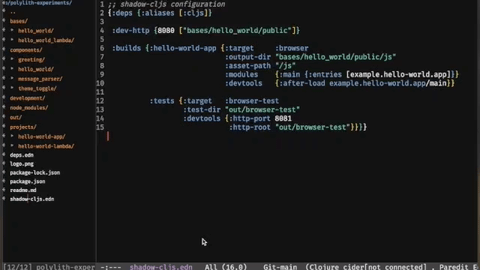"Pants is a fast, scalable, user-friendly build system for codebases of all sizes"
"Polylith helps us build simple, maintainable, testable, and scalable backend systems"
Can we use both? I have tried that out, and here's my notes.
Why?
Because The Developer Experience.
Developer Experience is important, but what does that mean? For me, it is about keeping things simple. The ability to write, try out and reuse code without any context switching. By using one single setup for the REPL and the IDE, you will have everything at your fingertips.
The Polylith Architecture solves this by organizing code into smaller building blocks, or bricks, and separating code from the project-specific configurations. You have all the bricks and configs available in a Monorepo. For Python development, you create one single virtual environment for all your code and dependencies.
There is also tooling support for Polylith that is useful for visualizing the contents of the Monorepo, and for validating the setup. If you already are into Pantsbuild, the Polylith Architecture might be the missing Lego bricks you want to add for a great Developer Experience.
Powerful builds with Pants
Pantsbuild is a powerful build system. The pants tool resolves all the dependencies (by inspecting the source code itself), runs the tests and creates distributions in isolation. The tool also support the common Python tasks such as linting, type checking and formatting. It also has support for creating virtual environments.
Dude, where's my virtual environment?
In the Python Community, there is a convention to name the virtual environment in a certain way, usually .venv, and creating it at the Project root (this will also likely work well with the defaults of your IDE).
The virtual environment created by Pants is placed in a dists folder, and further in a Pants-specific folder structure. I found that the created virtual environment doesn't seem to include custom source paths (I guess that would be what Pants call roots).
Custom source paths is important for an IDE to locate the Python source code. Maybe there are built-in ways in Pantsbuild to solve that already? Package management tools like Poetry, Hatch and PDM have support for configuring custom source paths in the pyproject.toml and also creating virtual environments according to the Python Community conventions.
Note: If you are a PyCharm user, you can mark a folder as a source root manually and it will keep that information in a cache (probably a .pth file).
Example code and custom scripts
I have created an example repository, a monorepo using Pantsbuild and Polylith. You will find Python code and configurations according to the Polylith Architecture and the Pantsbuild configurations making it possible to use both tools. In the example repo I have added a script that adds source paths, based on the output from the pants roots command, to the virtual environment created by Pantsbuild. This is accomplished by adding a .pth file to the site_packages folder. For convenience, the script will also create a symlink to a .venv folder at the root of the repo.
Having the virtual environment properly setup, you can use the REPL (my favorite is IPython) with full access to the entire code base:
source .venv/bin/activate ipython
With an activated virtual environment, you can also use all of the Polylith commands:
poly create poly info poly libs poly deps poly diff poly check poly sync
Pants & Polylith
Pantsbuild has a different take on building and packaging artifacts compared to other tools I've used. It has support for several languages and setups. Some features overlap with what's available in the well-known tooling in the Python community, such as Poetry. Some parts diverge from the common conventions.
Polylith has a different take on sharing code, and also have some overlapping features. Polylith is a Monorepo Architecture, with tooling support for visualizing the Monorepo. From what I've learned so far, the checks and code inspection features are the things you will find in both Pants and Polylith.
Pants operate on a file level. Polylith on the bricks level.
My gut feeling after learning about it and by experimenting, is that Pantsbuild and Polylith shares the same basic vision of software development in general and I have found them working really well together. There are some things I would like to have been a better fit, such as when selecting contents of the Pants-specific BUILD files vs the content in the project-specific pyproject.toml files.
Maybe I should develop a Pants Polylith plugin to fix that part. 🤔
How does that sound to you?
Resources
Top Photo by Studbee on Unsplash









